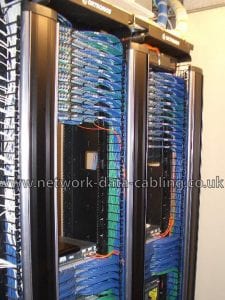or call 0333 900 0101
Ethernet cabling allows networks – and therefore those connected to that network – to access other computers which are also connected. This is often known as a LAN, or Local Area Network. For businesses, an Ethernet installation is useful when computers within the building need to share data: customer databases, for example. The structured cables used for Ethernet are most commonly copper Category 5e cables. ‘Ethernet’ does not refer to any specific type of cable, however, so other cables may be used to achieve the same purpose. Learn more about data cable types here.
What Is Ethernet?
The word ‘Ethernet’ refers to a specific family of computer networking technologies which are used for local area networks (LANs). This frame based technology defines specific standards under which LANs operate. Simply put, Ethernet is a system which allows computers within a network to connect to and interact with each other directly. It differs from the Internet in that there is no worldwide web; the connection is limited to the local computers which are hooked up to that specific network. An Ethernet user could access another computer’s files or a company database, for example, but could not use a web browser without having another, different connection to the Internet.
What is an ethernet cable used for?
Ethernet cables are used to connect devices within a local area network (LAN), such as computers, routers, switches, and gaming consoles. These advanced cables facilitate high-speed data transmission between devices, allowing them to communicate and share resources efficiently.You will find that Ethernet cables are mostly used for internet connections, file sharing, online gaming, and other data-intensive tasks.
What type of cable is ethernet?
Ethernet cables are usually twisted-pair cables made of copper or, in some cases, fiber optic materials. The most common type of Ethernet cable used today is the Category 5e (Cat 5e) cable, which supports data rates up to 1 gigabit per second (Gbps). The Higher-speed versions typically include Category 6 (Cat 6) and Category 6a (Cat 6a) cables, capable of handling data rates up to 10 Gbps and 10 Gbps to 100 Gbps, respectively. It is important to note that Fiber optic Ethernet cables use thin strands of glass or plastic to transmit data as pulses of light, offering even higher data transmission rates and immunity to electromagnetic interference.
History of Ethernet
Ethernet was developed between 1973 and 1975, and was patented by Xerox as a “multipoint data communication system.” Several companies, including DEC and Intel, collaborated to promote Ethernet as a standard for networking. Ethernet gained international approval in 1984.
The concept behind Ethernet has not really changed since its creation, and the framework behind it has remained constant. The actual connections based on Ethernet have become ever faster as cables grow more advanced. Originally, Ethernet connected computers within a network by allowing them to share a single coaxial cable. Eventually, this cable was replaced with point-to-point links, which enabled faster and more reliable connections. Now, twisted pair wiring is used to link computers within a network. Because the framework for Ethernet has remained constant through all the cable changes, all formats of Ethernet cabling are compatible with each other.
Functions of an Ethernet Cable Installation
Although Ethernet does not provide Internet access, it is still very useful and may be utilised for a number of functions. Recreationally, Ethernet facilitates multiplayer computer games. More importantly, Ethernet allows businesses to have company-specific databases which may be accessed by authorised users. A company database may store lists of customers, information about items in stock, or email response templates, for example. This information, which concerns only the company, should be kept private and so should not be published on the Internet. A local area connection, made possible by Ethernet, allows authorised users to access the information they need.
Ethernet also allows information in a database to be updated in real-time so that all other users can take note of changes. For example, consider an email response template with a typo. An administrator can modify the template to fix the mistake, and no further action is necessary since users access the template directly from the database. If each computer had its own template saved to its personal hard drive, it would be necessary to change every template individually – not the most efficient way to work!
Ethernet facilitates the rapid exchange of information and ensures that the information is the same for every user since it is held in only one database. For any business with a heavy reliance on computers, Ethernet is a must.
Who Benefits from Ethernet?
A local area connection is rather pointless when a business has only one or very few computers. Single-chain restaurants, for example, likely would not benefit from the use of Ethernet. However, any company which has or plans to have multiple computers would certainly benefit heavily from having a local network. Active Communications Company Ltd can help to determine whether or not a LAN is appropriate for any size business and what the intended purpose should be.
Types of Ethernet Cabling
As previously mentioned, the most common type of Ethernet cables are Cat5e: twisted pair, copper cables which enable very fast networking over moderate distances. When someone refers to “Ethernet cabling,” it can be assumed that he or she is referencing Cat5 or Cat5e cable. Other types of Category cable may be used as well, but older cables like Cat3 or Cat4 will of course be less efficient than newer and more advanced cables.
For very large networks, a fibre optic cable may form the backbone of the network – the interstate highway, of sorts – since it can transfer information more rapidly than copper cabling and so is less likely to be slowed when many users are accessing the network at once. For smaller networks, though, fibre optic cable is an unnecessary expense.
Learn more about choosing your Ethernet cable solution in our article Which Ethernet cable.
Other cabling types: Data cabling installation, Fibre optic cabling, WiFi cabling, Fire survival Cabling, Computer Cabling, Blown fibre cables
Installing Ethernet Cabling
It’s possible for very small Ethernet networks to be set up by the average consumer. However, any network which has a purpose beyond simple at-home use should be installed by a trained professional. Before network installation begins, an engineer must determine what types of cabling are ideal given the size and intended usage of the network and draw up plans of how the cables will be laid. Even small networks have dozens of wires to keep track of, and larger networks may have some hundreds. The cables must be installed perfectly in order for the network to function, and in some cases construction work may be necessary to prevent wires from becoming a tripping hazard. Since an Ethernet network is such an integral part of a business’ operation, there is no room for error. It’s smart to entrust network cabling to experienced professionals, like those at Active Communications Company Ltd.
Ethernet Cabling – Review
Ethernet cabling makes Ethernet possible, which in turn facilitates the use of local area networking. This allows computers within a business to interact directly with each other and to access company databases, which is useful for many different applications. Any business which relies even partially upon computers will be benefited by an Ethernet network. To install a functional network, trained and certified network installers are needed – and Active Communications Company Ltd has just that. With years of active experience and many satisfied clients, ACCL is sure to serve any Ethernet cabling need. If you’d like to learn more about data cabling installations, learn more by reading our structured cabling guide.
Get in touch
If you are interested in discussing an ethernet cabling solution for your Company, the experts are just a phone call away. Following an initial chat, a site visit will be scheduled at the earliest opportunity
For more information on ACCL’s ethernet cabling services call:
0333 900 0101
or email sales@network-data-cabling.co.uk
Related topics: What is under desk cabling Which ethernet cable














